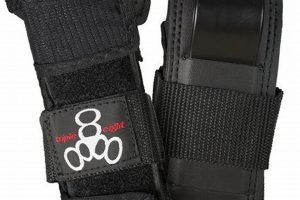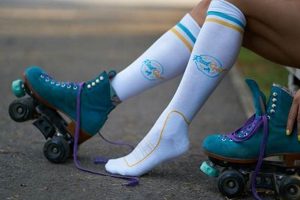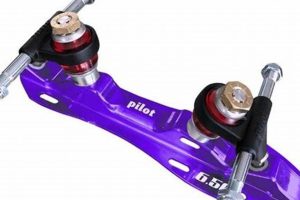Specialized inline skates engineered for performing tricks and stunts constitute a specific segment within the broader skating world. These skates are characterized by their robust construction, featuring reinforced frames and durable wheels designed to withstand the impacts associated with grinds, jumps, and other acrobatic maneuvers. A common example includes skates used in skate parks or on urban street obstacles, where skaters execute complex routines.
The importance of these specialized skates lies in their ability to facilitate progression and safety within extreme skating disciplines. Their design allows skaters to explore increasingly challenging tricks with a reduced risk of equipment failure. Historically, these skates evolved from standard inline skates to meet the demands of a growing community of skaters seeking to push the boundaries of the sport. This evolution has led to advancements in materials and construction techniques, enhancing performance and longevity.
The subsequent sections will delve into the specific components of these skates, exploring the nuances of frame design, wheel selection, and the role of bearings in optimizing performance. Additionally, different skating styles and the corresponding equipment variations will be addressed, providing a comprehensive overview of this specialized area.
Guidance on Selecting and Maintaining Specialized Inline Skates
This section provides crucial guidelines for individuals engaging with performance-oriented inline skates. Adhering to these recommendations can enhance safety, extend equipment lifespan, and improve overall skating experience.
Tip 1: Frame Integrity Assessment: Regularly inspect the skate frame for cracks, bends, or signs of stress, particularly around mounting points. A compromised frame can lead to instability and potential injury. Replacement is advised upon discovery of any structural weakness.
Tip 2: Wheel Durometer Consideration: Select wheel durometer (hardness) based on skating surface and desired performance. Softer wheels offer enhanced grip on slick surfaces, while harder wheels provide increased speed and durability on smoother terrains. Experimentation may be required to determine optimal durometer for individual preferences and skating environments.
Tip 3: Bearing Maintenance Schedule: Clean and lubricate bearings regularly to ensure optimal rolling efficiency. Debris accumulation within bearings can significantly reduce speed and increase friction. A dedicated bearing cleaning kit and lubricant are recommended.
Tip 4: Grind Block Evaluation: Inspect grind blocks for wear and tear, particularly if frequently used for grinding. Replace worn grind blocks to maintain consistent grind performance and prevent damage to the skate frame.
Tip 5: Liner Customization: Consider aftermarket liners to improve fit and comfort. A well-fitting liner enhances control and reduces the risk of blisters or pressure points during extended skating sessions. Heat-moldable liners can be customized to individual foot contours.
Tip 6: Hardware Tightness Verification: Periodically check the tightness of all bolts and screws on the skates. Loose hardware can compromise stability and lead to equipment failure. Use appropriate tools and torque specifications when tightening hardware.
Tip 7: Impact Absorption Enhancement: Evaluate the use of shock-absorbing insoles to mitigate impact forces on joints. These insoles can reduce fatigue and minimize the risk of injuries associated with high-impact landings.
These guidelines emphasize the importance of proactive maintenance and informed equipment selection. By implementing these strategies, skaters can optimize their performance, enhance safety, and extend the lifespan of their specialized inline skates.
The following sections will address advanced techniques and considerations for optimizing skate performance and personalizing the skating experience.
1. Frame Durability
Frame durability represents a critical performance parameter for specialized inline skates, directly impacting the equipment’s capacity to withstand the rigors of aggressive skating. These skates are subjected to substantial forces during landings, grinds, and other acrobatic maneuvers, placing immense stress on the frame. The frame’s capacity to resist deformation, fracture, or any form of structural failure is paramount for skater safety and consistent performance. Insufficient frame durability can lead to equipment breakdown, potentially resulting in serious injury. For example, a frame that cracks under impact during a rail grind will immediately destabilize the skater, likely causing a fall. The practical significance of robust frame construction is therefore directly linked to risk mitigation and the ability to execute advanced techniques with confidence.
Materials selection plays a pivotal role in determining frame durability. High-strength aluminum alloys and reinforced composites are frequently employed in the construction of aggressive skate frames to maximize resistance to stress and impact. The frame design itself also contributes significantly to overall strength. Features such as reinforced sidewalls, strategically placed gussets, and optimized load distribution patterns are commonly incorporated to enhance the frame’s ability to withstand extreme forces. Furthermore, the manufacturing process, including heat treatment and welding techniques, is crucial for ensuring the structural integrity of the frame.
In summary, frame durability is an indispensable characteristic of high-performance inline skates used in aggressive skating disciplines. Its impact extends from skater safety and injury prevention to the ability to reliably execute challenging tricks and routines. Prioritizing frame quality during equipment selection and diligently inspecting frames for signs of wear or damage are essential practices for maximizing both performance and safety within this demanding sport.
2. Wheel Hardness
Wheel hardness is a critical determinant in the performance characteristics of specialized inline skates. Its selection directly influences factors such as speed, grip, and durability, thereby shaping the skater’s experience and the equipment’s suitability for various skating environments.
- Durometer Scale and Measurement
Wheel hardness is quantified using the durometer scale, typically ranging from 70A (softest) to 100A (hardest). The “A” scale is standard for inline skate wheels. Lower durometer wheels offer increased grip and shock absorption but tend to wear down more quickly. Conversely, higher durometer wheels provide greater speed and resistance to abrasion, but may sacrifice traction on certain surfaces. The optimal durometer depends on the skater’s style and the prevailing skating conditions.
- Grip and Traction Considerations
Softer wheels, with lower durometer ratings, exhibit enhanced grip on slick or uneven surfaces. This characteristic is particularly beneficial for skaters who prioritize control and maneuverability, especially in environments with variable surface conditions. However, increased grip translates to higher rolling resistance, potentially reducing overall speed. The trade-off between grip and speed is a fundamental consideration when selecting wheel hardness.
- Speed and Rolling Resistance
Harder wheels, characterized by higher durometer ratings, offer reduced rolling resistance, resulting in increased speed. This advantage is most pronounced on smooth, consistent surfaces such as those found in skate parks or specialized skating rinks. While harder wheels excel in speed, they may lack the necessary grip for reliable performance on rough or slippery terrain. Skaters should carefully evaluate the surface characteristics of their intended skating environment when choosing wheel hardness.
- Durability and Wear Resistance
Wheel hardness significantly impacts the wheel’s lifespan. Softer wheels, while providing superior grip, are more susceptible to abrasion and wear. This is particularly evident when skating on abrasive surfaces such as concrete or asphalt. Harder wheels, on the other hand, demonstrate greater resistance to wear, extending their lifespan and reducing the frequency of replacements. However, excessively hard wheels may become brittle and prone to cracking under extreme stress.
In summary, wheel hardness is a multifaceted parameter that directly influences the performance and durability of specialized inline skates. The selection of appropriate wheel hardness necessitates careful consideration of factors such as surface conditions, skating style, and desired balance between grip, speed, and wear resistance. Understanding these interdependencies is crucial for optimizing the skating experience and ensuring the longevity of the equipment.
3. Bearing Precision
Bearing precision constitutes a critical factor influencing the performance and efficiency of specialized inline skates. Within aggressive skating, characterized by high-impact maneuvers and demanding conditions, bearing precision directly impacts the skater’s ability to achieve speed, maintain control, and execute complex tricks. Imprecise bearings generate increased friction, hindering rolling efficiency and requiring greater exertion from the skater. Conversely, high-precision bearings minimize friction, enabling smoother, faster rolls and enhancing overall maneuverability. For instance, during a vert ramp descent, bearings with a low ABEC rating (indicating lower precision) may exhibit increased resistance, making it more difficult to gain sufficient speed for a successful transition. High-precision bearings, however, allow for a smoother acceleration and a greater margin for error.
The ABEC (Annular Bearing Engineers’ Committee) scale is frequently used to categorize bearing precision, ranging from ABEC 1 (least precise) to ABEC 9 (most precise). However, it is essential to recognize that ABEC rating alone does not fully capture bearing quality. Factors such as material composition, internal clearance, and lubrication also play significant roles. Furthermore, the aggressive skating environment introduces unique stresses, including frequent impacts and exposure to dirt and debris, which can rapidly degrade bearing performance, regardless of initial precision. Therefore, regular cleaning and lubrication are essential for maintaining optimal bearing function in these skates.
In summary, bearing precision significantly contributes to the overall performance and efficiency of specialized inline skates. While ABEC rating offers a general indication of precision, a holistic assessment encompassing material, construction, and maintenance practices is crucial for selecting and maintaining bearings appropriate for aggressive skating. Ultimately, understanding the interplay between bearing precision and the demanding conditions of aggressive skating enables skaters to optimize their performance, enhance safety, and extend the lifespan of their equipment.
4. Grind Block Material
Grind block material is a fundamental component within the design of specialized inline skates. Its properties directly influence the skater’s ability to execute grinding maneuvers effectively and safely. Understanding the characteristics of different materials is essential for selecting equipment that aligns with specific skating styles and environmental conditions.
- Friction Coefficient
The friction coefficient of the grind block material dictates the ease with which a skater can slide along surfaces such as rails, ledges, and coping. Materials with low friction coefficients, such as certain types of high-density polyethylene (HDPE), facilitate smoother and faster grinds. Conversely, materials with higher friction coefficients may provide more control, but at the expense of speed. In practice, skaters often select grind block materials based on their preference for speed versus control. For example, a skater prioritizing high-speed rail slides might opt for HDPE, while a skater focused on intricate ledge maneuvers could prefer a material with slightly higher friction.
- Abrasion Resistance
Abrasion resistance determines the durability of the grind block material when subjected to the repetitive friction of grinding. Materials with high abrasion resistance, such as certain types of nylon or polyurethane, can withstand prolonged use without significant degradation. In contrast, materials with lower abrasion resistance will wear down more quickly, requiring frequent replacement. The selection of grind block material with appropriate abrasion resistance is crucial for skaters who frequently engage in grinding maneuvers. Skaters who commonly skate in rough environments may opt for material with higher abrasion resistance, ensuring long-term performance.
- Impact Strength
Impact strength is the capacity of the grind block material to withstand sudden, forceful impacts without fracturing or cracking. Grinding often involves landing on the grind block from a height or impacting it against obstacles. Materials with high impact strength, such as reinforced nylon composites, are better equipped to absorb these forces and prevent damage. The impact strength of the grind block material is directly related to skater safety, as a fractured grind block can lead to instability and potential injury. Skaters who perform more advanced, high-impact grinds should prioritize grind blocks constructed from materials with high impact strength.
- Material Density
Material density affects the overall weight and balance of the skate. Lighter grind block materials can improve maneuverability and reduce fatigue, while denser materials may provide increased stability. The selection of grind block material with appropriate density involves a trade-off between agility and stability. Skaters who prioritize quick turns and aerial maneuvers may prefer lighter materials, while those who favor stability during grinds could opt for denser materials. Material density influences skate weight and can affect jump height and agility. For example, a lighter material may allow for higher jumps, but make landing a bit less stable. So choose the right density.
The properties of grind block material significantly impact both the performance and safety characteristics of specialized inline skates. By carefully considering factors such as friction coefficient, abrasion resistance, impact strength, and material density, skaters can optimize their equipment for specific skating styles and environmental conditions, ultimately enhancing their overall skating experience.
5. Liner Comfort
Liner comfort is a critical determinant of performance and safety in aggressive inline skating. The liner, the inner boot of the skate, serves as the primary interface between the skater’s foot and the rigid outer shell. Its design and material composition directly influence the skater’s ability to maintain control, execute complex maneuvers, and endure prolonged skating sessions. Inadequate liner comfort can lead to discomfort, blisters, pressure points, and ultimately, reduced performance and increased risk of injury.
- Anatomical Fit and Support
The liner’s anatomical fit is paramount for providing adequate support and preventing foot movement within the skate. Liners designed to conform to the natural contours of the foot minimize friction and pressure points. Examples include liners with integrated arch support and strategically placed padding in areas prone to pressure, such as the ankle and heel. A well-fitting liner enhances control by ensuring that the skater’s movements are directly translated to the skate, and reduces the risk of blisters. This is particularly important in aggressive skating, where precise footwork is essential for executing tricks. For instance, a liner that allows excessive heel lift can impair the skater’s ability to perform grinds or landings effectively.
- Moisture Management and Breathability
Aggressive skating is a physically demanding activity that generates significant heat and perspiration. Liners constructed from breathable materials, such as moisture-wicking fabrics, help to regulate foot temperature and minimize moisture build-up. This reduces the risk of discomfort, blisters, and fungal infections. Examples include liners with ventilation channels and fabrics with inherent moisture-wicking properties. Efficient moisture management contributes to overall comfort and hygiene, allowing skaters to focus on their performance without distraction. A damp liner not only causes discomfort, but can also increase the risk of skin irritation and friction blisters.
- Impact Absorption and Cushioning
Aggressive skating involves repeated impacts from jumps, landings, and grinds. Liners with integrated impact absorption features, such as gel padding or multi-density foam, help to attenuate these forces and protect the foot and ankle from injury. Examples include liners with shock-absorbing insoles and strategically placed padding in high-impact areas. Adequate cushioning reduces the risk of bruising, stress fractures, and other impact-related injuries. This is especially crucial for skaters who regularly perform high-impact maneuvers or skate on hard surfaces. For example, a liner lacking sufficient cushioning can result in persistent foot pain and fatigue after extended skating sessions.
- Customization and Adjustability
The ability to customize and adjust the liner’s fit is essential for accommodating individual foot shapes and preferences. Liners with features such as heat-moldable materials, adjustable straps, and removable components allow skaters to fine-tune the fit and optimize comfort. Examples include liners that can be heat-molded to conform to the specific contours of the foot and liners with adjustable ankle straps for enhanced support. Customization options enable skaters to achieve a personalized fit that minimizes pressure points and maximizes comfort, leading to improved performance and reduced risk of injury. A customized fit improves efficiency as the skaters power transfer is increased. The skate becomes a more accurate representation of the skaters intention.
In summary, liner comfort represents a critical aspect of specialized inline skates, directly impacting performance, safety, and overall skating experience. By prioritizing anatomical fit, moisture management, impact absorption, and customization options, skaters can optimize liner comfort and enhance their ability to execute complex maneuvers with confidence and minimize the risk of injury. The interplay between the skate and liner needs to be seamless to create the connection between intent and movement.
6. Ankle Support
Ankle support constitutes a critical design element within specialized inline skates, particularly those engineered for aggressive skating disciplines. The inherent instability of inline skates, coupled with the high-impact forces and dynamic movements characteristic of aggressive skating, necessitates robust ankle support mechanisms. Insufficient ankle support can lead to a cascade of negative consequences, ranging from compromised performance to acute or chronic injuries. The primary function of ankle support is to stabilize the ankle joint, limiting excessive lateral or medial movement and preventing hyper-extension or hyper-flexion during landings, grinds, and other maneuvers. For example, when executing a jump and landing with slight asymmetry, adequate ankle support prevents the ankle from rolling inward or outward, thus mitigating the risk of a sprain. Without this support, the likelihood of injury is significantly amplified, particularly for skaters attempting complex tricks.
The implementation of effective ankle support within aggressive inline skates involves a multifaceted approach encompassing both structural design and material selection. High-cut cuffs, typically constructed from rigid plastics or reinforced composites, provide a secure enclosure around the ankle joint. These cuffs often incorporate adjustable straps or buckles, enabling skaters to customize the fit and level of support according to individual preferences and skating styles. Furthermore, the internal liner design contributes significantly to ankle support. Liners incorporating dense padding or supportive inserts around the ankle area enhance stability and reduce the likelihood of unwanted movement. The practical significance of understanding these design elements lies in the ability to select skates that provide adequate ankle support for a given skating style and skill level. Skaters engaging in more demanding tricks or skating on uneven surfaces will require a higher degree of ankle support compared to those performing less strenuous maneuvers on smoother surfaces.
In summary, ankle support is not merely a comfort feature but an essential safety component of specialized inline skates. Its presence mitigates the risk of ankle injuries, enabling skaters to execute complex maneuvers with greater confidence and control. Understanding the relationship between structural design, material selection, and the biomechanics of ankle support is crucial for selecting appropriate equipment and ensuring a safe and productive skating experience. The potential challenges associated with inadequate ankle support underscore the importance of prioritizing this feature when choosing aggressive inline skates, with consideration given to both the skater’s skill level and the intended application.
7. Impact Resistance
Impact resistance constitutes a paramount characteristic of specialized inline skates. The aggressive skating discipline subjects equipment to extreme conditions, involving repeated landings from significant heights, collisions with obstacles, and sustained stress from grinding maneuvers. Insufficient impact resistance directly correlates with equipment failure, leading to potential injury. Frame fractures, wheel delamination, and bearing disintegration are direct consequences of inadequate impact resistance. A real-world example involves a skater attempting a gap jump, where the landing force concentrates on the skate frame; if the frame lacks sufficient impact resistance, it may crack, resulting in a loss of control and a potential fall. Understanding the material properties and structural designs that contribute to impact resistance is therefore crucial for mitigating risk and ensuring equipment longevity.
The incorporation of high-impact resistant materials represents a key strategy for enhancing the durability of specialized inline skates. High-density polymers, reinforced composites, and specialized alloys are commonly employed in the construction of skate frames, wheels, and bearing components. These materials are selected for their ability to absorb and dissipate energy upon impact, minimizing the risk of structural failure. Furthermore, design features such as reinforced sidewalls, shock-absorbing liners, and strategically placed impact zones contribute to overall impact resistance. Consider the design of the wheel core, which is engineered to withstand the forces generated during landings; a poorly designed core may shatter upon impact, rendering the wheel unusable and potentially causing a loss of balance. The practical application of these design principles is evident in the enhanced durability and performance of high-end aggressive skates.
In summary, impact resistance is an indispensable attribute of specialized inline skates. Its presence dictates the equipment’s ability to withstand the rigors of aggressive skating, directly influencing skater safety and performance. The selection of appropriate materials, coupled with strategic design considerations, is essential for maximizing impact resistance and minimizing the risk of equipment failure. By prioritizing impact resistance, skaters can enhance their confidence, extend the lifespan of their equipment, and minimize the potential for injury, ultimately contributing to a more rewarding and sustainable skating experience. Future research and development efforts should focus on further enhancing impact resistance through innovative materials and advanced design techniques.
Frequently Asked Questions
The following section addresses common inquiries regarding specialized inline skates, providing objective information to enhance understanding and inform decision-making.
Question 1: What distinguishes specialized inline skates from recreational models?
Specialized inline skates are engineered for durability and performance in extreme skating environments. They feature reinforced frames, high-durometer wheels, and robust construction to withstand the impacts associated with aggressive skating.
Question 2: What are the key considerations when selecting specialized inline skates?
Factors such as frame material, wheel hardness, bearing precision, liner comfort, and ankle support are crucial. Selection should align with individual skating style, skill level, and intended usage environment.
Question 3: How frequently should specialized inline skates be maintained?
Maintenance frequency depends on usage intensity and environmental conditions. Regular inspection, cleaning, and lubrication are essential for preserving performance and extending equipment lifespan. Wheel rotation and bearing maintenance should be performed periodically.
Question 4: Can specialized inline skates be used for recreational skating?
While specialized inline skates can be used for recreational skating, their design is optimized for aggressive skating maneuvers. Recreational skaters may find them less comfortable or efficient for distance skating due to their stiffer construction and smaller wheel size.
Question 5: What safety precautions are essential when using specialized inline skates?
Protective gear, including helmets, knee pads, elbow pads, and wrist guards, is strongly recommended. Skaters should familiarize themselves with safe skating practices and avoid attempting maneuvers beyond their skill level.
Question 6: What is the expected lifespan of specialized inline skates?
Lifespan varies depending on usage intensity, maintenance practices, and equipment quality. Regular maintenance and timely replacement of worn components can significantly extend the lifespan of specialized inline skates.
These questions and answers provide a foundational understanding of specialized inline skates. Informed decision-making, coupled with proper maintenance and safety precautions, is essential for a positive skating experience.
The subsequent section will explore advanced techniques and customization options for optimizing performance in specialized inline skating.
Conclusion
This exploration of rollerblades aggressive skates has elucidated the crucial design elements and performance considerations inherent in this specialized equipment. Frame durability, wheel hardness, bearing precision, liner comfort, ankle support, and impact resistance are all identified as critical factors influencing skater safety, performance, and equipment longevity. A thorough understanding of these attributes allows skaters to make informed decisions regarding equipment selection and maintenance.
The continued advancement of materials and design technologies promises further enhancements in the performance and safety of rollerblades aggressive skates. A commitment to rigorous maintenance and responsible skating practices remains paramount. The knowledge conveyed serves to empower skaters to maximize their potential while minimizing the inherent risks associated with this demanding discipline, solidifying its place in sporting landscape.







